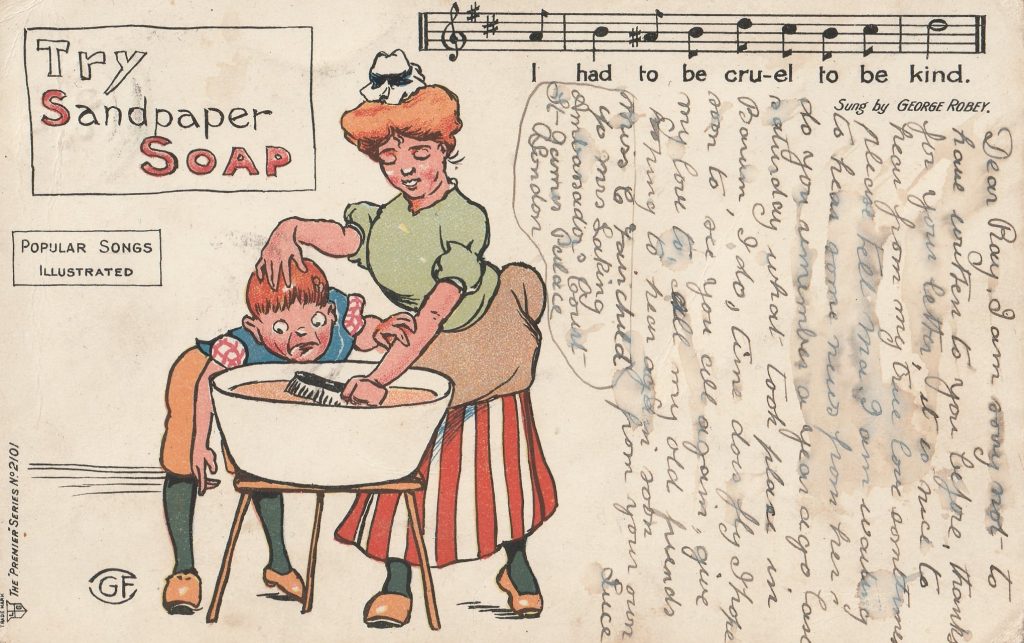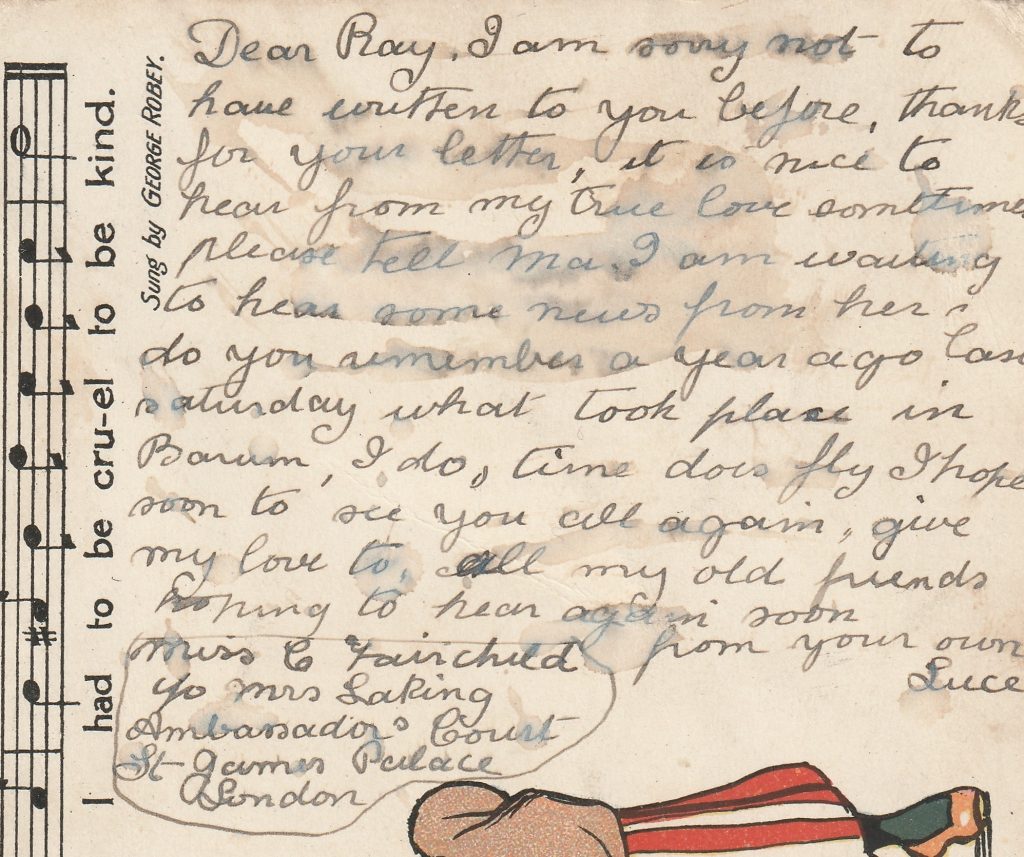Bob Teevan
Sandpaper Soap
When it’s Saturday night what better way to celebrate than to have your neck washed? Washed is a good word but scrubbed would be a better term. Many of us have memories of childhood and being forcibly scrubbed. The neck was a favored target of my mother although it was the time ‘short back and sides’ haircuts and the neck was always on show. We never had much as children although we were always spotlessly clean to the extent that we glowed in the dark.

This is an early undivided back card published by William Lyon of Glasgow, Scotland. (Look for the ‘LG’ set within a quartered shield in lower left corner). “Founded by William Lyon when he was only 23 years old, the company prospered, and by 1885 there was the shop at 385 Sauchiehall Street, a printing works at number 474 Sauchiehall Street and a retail branch in the Argyll Arcade. He published Popular Songs Illustrated and Popular Novels Illustrated.
Lyon published comic cards by the artist G. F. Christie; there are his initials in the bottom left corner. George Fyffe Christie was a freelance commercial artist who drew humorous postcards, not least for William Lyon in the undivided back era. He had a long career during which he also wrote and illustrated children’s books. He was living in the English town of Bushey, Hertfordshire when he met and married Ethel. Their son was the figurative artist and mural painter Fyffe Christie.
Around 1930 Ethel died and the family moved to Glasgow’s Pollokshields district. Christie had some commercial success with his cartoon strip Scottikin O’ the Bulletin in a popular Glasgow newspaper The Bulletin but he struggled financially through the years of the recession and discouraged his son’s artistic ambition. He later worked for the American-style comics published in Scotland by Cartoon Art Productions, including Razzle-Dazzle (1946-47) and G-Boy Comics (1947).
The illustration features a young boy leaning over a large basin with his head being firmly held in place. His ‘opponent’ in this contest is arguably his mother who has a firm grip of her son in one hand and a brush in the other. The lad has no chance of escape and would be as well to call a submission.
The wording ‘Try Sandpaper Soap’ only adds to my concern for the child although I suspect that the soap is carbolic and emits its distinctive odor. I think Christie has used color well here and has emphasized the Scottish heritage of his characters by giving them both red hair – although I think the red hair on the mother is also reflective of determination and strength.
The Popular Song Illustrated is I had to be cruel to be kind. This expression was one used by my mother – perhaps as a consequence of having three unruly charges.
The song by George Arthur and Bennett Scott was performed by George Robey as is stated on the postcard. The reference to Robey was useful as it appears that much of the world knows only of the song Cruel to be Kind by Nick Lowe and credit his work of the 1970s as being the original. The phrase predates both Robey and Lowe, for there is a newspaper reference to the phrase ‘cruel to be kind’ as far back as 1831. And that is trumped by William Shakespeare who used the line ‘I must be cruel, only to be kind’ in Hamlet (Act 3, Scene 4) way back in 1609.
The postcard, sent to Miss A. R. Easton, 34 High Street, Barnstaple, N. Devon was postmarked from South Lambeth on February 9, 1904. The salutation is ‘Dear Ray’ and in addition to signing off with the name ‘Luce’ the sender added her contact details: Miss C Fairchild, c/o Mrs. Laking, Ambassador Court, St. James Palace, London.
I will leave you to read the message if you wish. It is routine in type, but includes a couple of comments which may initially mislead the reader. For example, it reads “It is nice to hear from my true love…” and “Do you remember a year ago last Saturday what took place in Barum,” and “I do.” When I first read this, I thought of Luce and Ray as lovers, and whatever took place in Barum was something not to be forgotten!

I turned to the Census records and very easily found the Easton family living at 34 High Street, Barnstaple at the time of the 1901 Census. This family comprised James Easton, a 42-year-old watchmaker and his 40-year-old wife Eliza A. Easton. Also at home were three children with the youngest child being their 9-year-old daughter Alice R. Easton. The initials and the address fit the card perfectly and this must be Ray, to whom the card is addressed. She is not a young male lover who may have been up to no good last year but in 1904 will be a 12-year-old girl.
Also in the house in 1901 was a female boarder (aged 69) and a 27-year-old general domestic servant named Lucy Fairchild. Miss Fairchild was born in Fremington in Devon. Then to the 1911 census (hoping to find her at the sender’s address) Lucy Fairchild was now Mrs. Lucy Duffin, aged 37 and living with her husband Alfred, a railway brakeman. Luce is surely short for Lucy leaves me with little doubt that this is the sender of the card. What happened a year ago is unknown and presumably innocent and Miss Fairchild must have had a good relationship in Barnstaple with Ray to refer to her as her true love.
I have to qualify my findings and tell you that according to the records Lucy Fairchild married Alfred Duffin in early 1903. Why would she refer to herself as a Miss Fairchild one year after her marriage? Was this to simplify things for a child? Lucy had a sister named Clara and because I could not determine whether Luce’s initial was an ‘L’ or a ‘C’ I also followed her. She was also born in Fremington and moved to London where she became a cook in domestic service. Was Luce providing Ray with Clara’s address? By 1939 Lucy was a widow living in Woking. Living with her were two women; one of whom was her sister Clara Fairchild, an unemployed servant.
I remember when a certain TV show which combined comedy and country music featured the line “Saturday night: Time for a bath and ‘Hee Haw’” in a TV Guide ad. I thought the reference was a joke playing on the stereotype of unwashed hicks, as my mother had us bathe every day or two, but was assured that the once-a-week timing had been common in urban and rural areas alike.
As a child I was washed every day although the zinc bath was removed from the wash house (a sort of communal laundry) only on Sundays. We had no indoor bathroom and no hot water tap. The bath was filled using an electric geyser and gas heated kettles and we would be bathed in front of the fire. (No central heating).This was Scotland in the 1960s for a less than well off family.
I’m guessing that the words “sandpaper soap” are a joke, rather than a real brand.
Thanks for illuminating the phrase “Cleanliness is next to Godliness.”